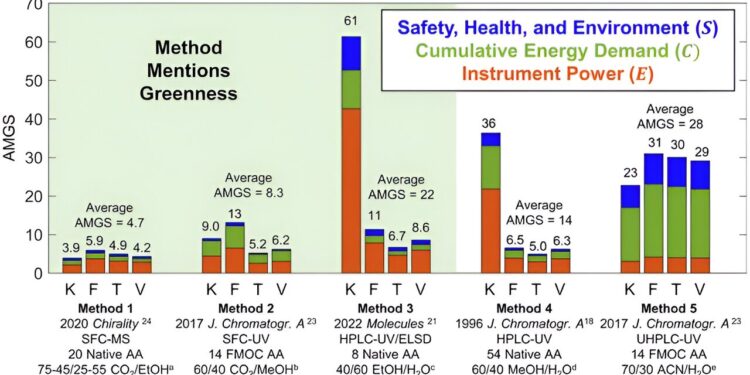Assessment of the Analytical Method Greenness Score (AMGS) of previously published methods. The contributions of instrument power (E), cumulative energy demand (C), safety, health and environment (S) are stacked (from bottom to top) so that the Total magnitude of the bar represents the AMGS of the method. The impact of additives was not taken into account. The analysis time was considered equal to the retention time of the second enantiomer, except for methods 2 and 5, where run times were provided. aMethod 1 requires TFA as an additive and an additional solvent for the booster pump containing 90/10 MeOH/H.2O at a flow rate of 0.25 mL min−1. bFormic acid (2% in MeOH) was used as an additive. cAcetic acid was used as an additive at pH 3.9. Acetic acid was used for lysine at a pH of 3.9. eFormic acid (2%) was used as an additive. Credit: Green chemistry (2023). DOI: 10.1039/D3GC03005A
Journal editors and reviewers Green chemistry have highlighted a new study from the University of Texas at Arlington, which explores how to make common chemical techniques more environmentally friendly, as one of its “hot” articles for 2023.
UTA scientists led by Daniel W. Armstrong, Welch professor emeritus of chemistry and biochemistry, have discovered that using carbonated water in chromatography makes this relatively common chemical technique more environmentally friendly.
A technique that involves taking a mixture and separating it to examine the individual components, chromatography is widely used to test athletes’ urine for performance-enhancing drugs, analyze crime scene evidence such as blood and clothing, test ingredients in food or measure the amount of alcohol in drinks, among many other uses. A single chromatograph produces about a liter of liquid waste, and some large pharmaceutical companies perform more than 1,000 chromatographic studies per day.
The use of carbonated water in chromatography can reduce the Analytical Method Greenness Score (AMGS). The smaller the score, the more environmentally friendly the process, Armstrong said.
“Our research shows that using simple soda water, combined with minimal mathematical processing and optimal column geometries, produces the lowest AMGS scores ever recorded,” Armstrong said. “This shows that switching to gaseous liquids rather than other liquids where possible will help make the chromatography process safer for the environment.”
The team also found that using gaseous liquids is just as fast and effective as other liquids used in chromatography.
“Using 38 amino acids as a test class of molecules, the utility of gaseous liquids as a green alternative has been demonstrated at speeds, efficiencies and resolutions never before reported,” Armstrong said. “Future work will involve applying what we have learned about carbonate liquids in chromatography to other methodologies, such as mass spectrometry.”
This study also corrected the original AMGS equation and extended it to cover more realistic separations, including chiral amino acids. The research also noted that this same approach would be useful for NASA, which has a particular interest in developing small, lightweight instruments for in situ extraterrestrial chiral/achiral chemical analysis.
Co-authors include M. Farooq Wahab, an engineering researcher, as well as two students: Troy T. Handlovic and Bailey C. Glass. Handlovic earned a bachelor of science degree in chemistry and a master of science degree in pharmaceutical chemistry from Fairleigh Dickinson University in Madison, New Jersey, before coming to UTA to pursue his doctorate. Glass, an Arlington native, is a second-year undergraduate research assistant studying biochemistry and plans to continue studying chemistry in graduate school.
More information:
Troy T. Handlovic et al, Optimizing greenness scores of analytical methods: a case study of amino acid enantioseparations with carbonated aqueous systems, Green chemistry (2023). DOI: 10.1039/D3GC03005A
Provided by the University of Texas at Arlington
Quote: The use of carbonated water in chromatography allows a more ecological process, according to a new study (December 20, 2023) retrieved on December 21, 2023 from
This document is subject to copyright. Apart from fair use for private study or research purposes, no part may be reproduced without written permission. The content is provided for information only.



